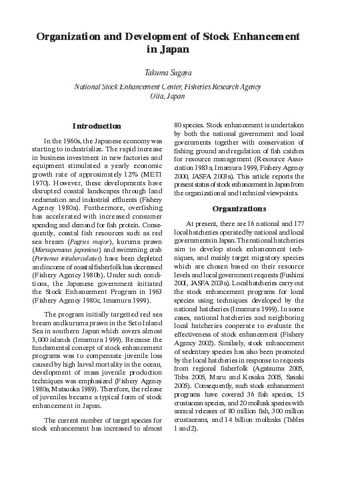Resources Conservation and Enhancement in Nam Houm Reservoir, Lao PDR
Share
Abstract
In 2010, the Training Department of the Southeast Asian Fisheries Development Center (SEAFDEC/TD) in cooperation with Department of Fisheries of Thailand and Department of Livestock and Fisheries of Lao PDR embarked on a five-year project on Rehabilitation of Fisheries Resources and Habitat/Fishing Grounds for Resources Enhancement funded by Japanese Trust Fund 5 (JTF-5). The selected project pilot site was Nam Houm Reservoir in Lao PDR. Mainly used support agriculture, Nam Houm Reservoir has water serving capacity of 60 million m3 in wet season. The total population from four villages near the Reservoir is 3,300 and as reported there are 36 species of fish in Nam Houm Reservoir. The main valuable and market species are tilapia Oreochromis niloticus, featherback fish Notopterus notopterus, and common silver barb Barbonymus gonionotus (Bleeker, 1849). The Project carried out various activities including improvement of fisheries information and data collection, promotion of sustainable fisheries and the concept of community-based and co-management in inland fisheries, strengthening of critical habitat protection measures by installing 50 pieces of highly effective fish shelter with fishing gear prevention tools in the conservation area to protect broodstocks from illegal fishers, technology transfer of mobile hatchery to the fishers group at Nam Houm Reservoir, as well as promotion of breeding techniques for common silver barb by injecting hormones to broodstocks and juvenile fish releasing techniques. All activities were successfully undertaken with the cooperation of Nam Houm Reservoir Fishery Management Committee (RFMR) and local fishers. The Project also demonstrated a good practice of comanagement between local people and government in the inland fishery sector. Moreover, the technical knowledge and techniques from the team of experts had been transferred to local officers and local people during the Project period. Now, the local people can apply and develop more techniques appropriate for reservoir fisheries in the country to achieve the goal of sustainable inland fisheries management in the future.
Suggested Citation
Phomsouvanh, A., Phounsavanth, S., Phengsakoun, S., Theparoonrat, Y., Manajit, N., Yingyuad, W., & Amornpiyakrit, T. (2016). Resources conservation and enhancement in Nam Houm Reservoir, Lao PDR. In H. (ed) Kawamura, T. (ed) Iwata, Y. (ed) Theparoonrat, N. (ed) Manajit, & V. T. (ed) Sulit (Eds.), Consolidating the Strategies for Fishery Resources Enhancement in Southeast Asia. Proceedings of the Symposium on Strategy for Fisheries Resources Enhancement in the Southeast Asian Region, Pattaya, Thailand, 27-30 July 2015 (pp. 99-101). Samutprakan, Thailand: Training Department, Southeast Asian Fisheries Development Center.
Subject
resource management  ; stocking (organisms)
; stocking (organisms)  ; sustainable fishing
; sustainable fishing  ; resource conservation
; resource conservation  ; carrying capacity
; carrying capacity  ; fry
; fry  ; nursery grounds
; nursery grounds  ; stock assessment
; stock assessment  ; larvae
; larvae  ; overfishing
; overfishing  ; environmental factors
; environmental factors  ; sustainability
; sustainability  ; socioeconomic aspects
; socioeconomic aspects  ; fishery management
; fishery management  ; fingerlings
; fingerlings  ; stocks
; stocks  ; Japan; Verasper moseri; Paralichthys olivaceus; Scomberomorus niphonius; Pagrus major; Oncorhynchus keta
; Japan; Verasper moseri; Paralichthys olivaceus; Scomberomorus niphonius; Pagrus major; Oncorhynchus keta
 ; stocking (organisms)
; stocking (organisms)  ; sustainable fishing
; sustainable fishing  ; resource conservation
; resource conservation  ; carrying capacity
; carrying capacity  ; fry
; fry  ; nursery grounds
; nursery grounds  ; stock assessment
; stock assessment  ; larvae
; larvae  ; overfishing
; overfishing  ; environmental factors
; environmental factors  ; sustainability
; sustainability  ; socioeconomic aspects
; socioeconomic aspects  ; fishery management
; fishery management  ; fingerlings
; fingerlings  ; stocks
; stocks  ; Japan; Verasper moseri; Paralichthys olivaceus; Scomberomorus niphonius; Pagrus major; Oncorhynchus keta
; Japan; Verasper moseri; Paralichthys olivaceus; Scomberomorus niphonius; Pagrus major; Oncorhynchus keta
Related items
Showing items related by title, author, creator and subject.
-
Thailand's concerns in endangered species and stock enhancement
Chaengkij, Marnop (Aquaculture Department, Southeast Asian Fisheries Development Center, 2006)The paper provides a comprehensive list of endangered freshwater, brackishwater, and marine aquatic species in Thailand. The Thai Department of Fisheries is breeding some of the endangered species under the “Rehabilitation ... -
Organization and development of stock enhancement in Japan
Sugaya, Takuma (Aquaculture Department, Southeast Asian Fisheries Development Center, 2006)In the 1960s, the Japanese economy was starting to industrialize. The rapid increase in business investment in new factories and equipment stimulated a yearly economic growth rate of approximately 12% (METI 1970). However, ... -
ASEAN-SEAFDEC directives related to species of international concern
Vichitlekarn, Suriyan (Aquaculture Department, Southeast Asian Fisheries Development Center, 2006)To achieve sustainable fisheries for food security in the ASEAN region, the Resolution (RES) and Plan of Action (POA) urge the Member Countries to rectify their fisheries practices through improvement of existing fisheries ...




